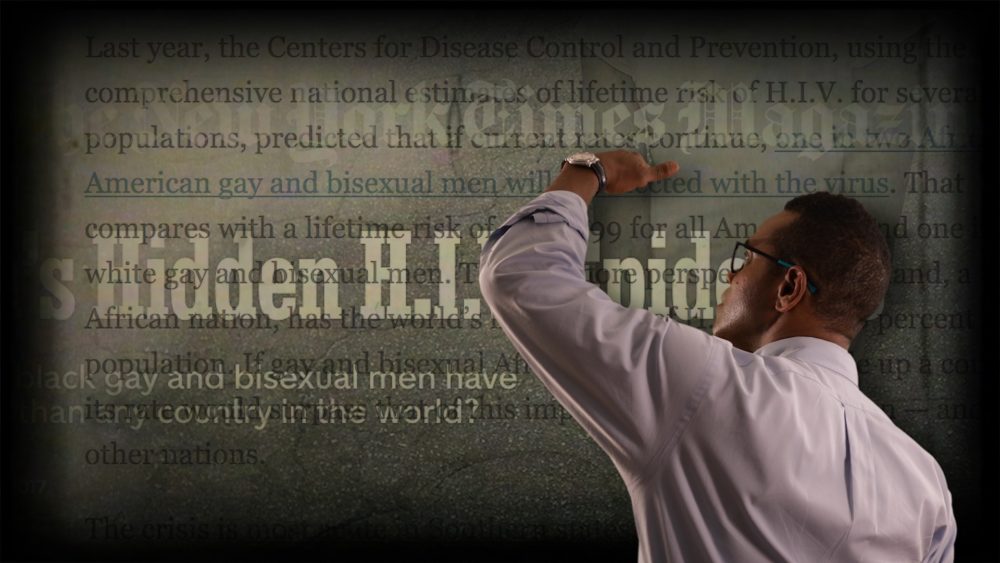For Day With(out) Art 2017, Visual AIDS commissioned seven new and innovative short videos from artists Mykki Blanco, Cheryl Dunye & Ellen Spiro, Tourmaline, Thomas Allen Harris, Kia LaBeija, Tiona Nekkia McClodden and Brontez Purnell. Curated by Erin Christovale and Vivian Crockett for Visual AIDS, the video program ALTERNATE ENDINGS, RADICAL BEGINNINGS prioritized Black narratives within the ongoing AIDS epidemic.
Below, Linda Villarosa responds to Thomas Allen Harris' video About Face: The Evolution of a Black Producer. Read Thomas Allen Harris' artist statement here.
Announcements
Thursday March 22, 2018
Linda Villarosa on “About Face: The Evolution of a Black Producer”

Thomas Allen Harris, "About Face: The Evolution of a Black Producer," 2017. Still courtesy the artist.
Linda Villarosa responds to About Face: The Evolution of a Black Producer by Thomas Allen Harris
In 1989, Thomas Allen Harris was an ambitious young producer working on public affairs shows at WNET, the New York City PBS affiliate. Also gay, he was stunned and horrified as AIDS raced its way through New York City, stealing away his friends and colleagues who died with little notice or representation. That year he pitched two segments to the executives at WNET: “Arts & AIDS” and “Art & Politics.” Together, the shows addressed the collision of the AIDS crisis and the Culture Wars of the late 80s and early 90s—and the groundswell of activism that followed—and allowed Harris to find his voice as an artist, activist and journalist.
Harris tells his story in About Face: The Evolution of a Black Producer, a short film commissioned by Visual AIDS as part of ALTERNATE ENDINGS, RADICAL BEGINNINGS, presented as part of the 28th annual Day With (out) Art for World AIDS Day 2017. His 8-minute documentary is based loosely on an essay of the same title that appears in the 1992 collection “Black Popular Culture,” a book edited by author Gina Dent. Using re-surfaced footage, iconic photography and griot storytelling, Harris lifts his original essay off the page, offering a kaleidoscopic tour through the LGBT and media landscapes of the early AIDS era.
Eventually, thanks largely to the noisy, insistent activism of the time, the media couldn’t help but cover the AIDS crisis. But that coverage, as Harris says, neglected the communities of color he knew intimately. The media kept an almost exclusive focus on gay white men, mainly in Manhattan and San Francisco, even as the disease was ripping its way through communities like Harlem, Fort Greene, Brooklyn and Oakland. The work of Joseph Beam, Assoto Saint, Essex Hemphill, Marlon Riggs and the Other Countries collective documenting the lives of gay black men during the height of AIDS barely created a ripple on the mainstream surface at the time. By the end of the 1980s, Alvin Ailey, designer Willi Smith, Sylvester and other black gay luminaries had died of AIDS while the primary narrative stayed stubbornly trained on gay white men. The story of AIDS in black America was generally reduced to the image of basketball star Magic Johnson tearfully announcing in 1991, “Because of the HIV virus I have obtained, I will have to retire from the Lakers today.” The parallel lives of black gay men remained mostly unexamined.
Harris took note of the lack of people of color in AIDS media coverage and began to push for a more diverse snapshot of the epidemic on PBS. In 1991, he produced “Adolescents and AIDS,” a segment for Thirteen Live. It featured a little seen monologue by a teenage Kerry Washington, taking part in a community theater project. “I’m here in the doctor’s office. I’m here to take some kind of AIDS test that I don’t know much about,” she says to the camera, looking both baby-faced and fierce in her pre-“Scandal” days. “I mean I’m 14; how am I supposed to deal with all of this?”
Harris also produced a segment called “Doctors & AIDS” in 1991, bringing together a panel composed of both physicians and activists. At one point, one of the activists, an HIV positive grandmother and former IV drug user, confronts the doctors and by proxy the medical establishment, accusing them of discriminating against her because of her background and the disease. One of the doctors, an African-American woman, validates her experience.
After the program, Harris’s executives called him to the carpet, labeling the program a failure. They accused him of poor judgment by booking the Latina activist who they called “inarticulate.” That was the final insult for Harris. He left public television shortly after to break out of the constraints and invisibility he felt as a broadcast producer in corporate media to explore, as he describes it, “issues of power, body and fantasy in a more public yet personal way as an artist.” (In the film, he waves good-bye and literally flies fly out of the frame.) Harris’s daring, thoughtful and introspective work as a photographer and filmmaker beginning in 1992 explores what he calls “the ways we can see our beauty and our value to love ourselves more deeply and engage with each other with fullness.”
As Harris’s documentary strikingly attests, the experiences of people of color in the narrative of the epidemic have been scrubbed away. At best, we are footnoted in both the classic and resurgent books, plays and films that chronicle the AIDS crisis. At worst, our experiences have been erased, stolen, co-opted, and appropriated. This erasure matters: The stories of black gay men, both the tragedy and the triumph, deserve to be heard. They help show, as Harris says, “that our lives are worth saving and fighting for.”
Linda Villarosa runs the journalism program at the City College of New York in Harlem and is a contributing writer to the New York Times Magazine. Her June cover story, "America’s Hidden HIV Epidemic," was one of the magazine’s most popular articles of 2017.
